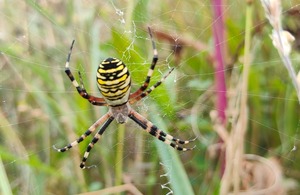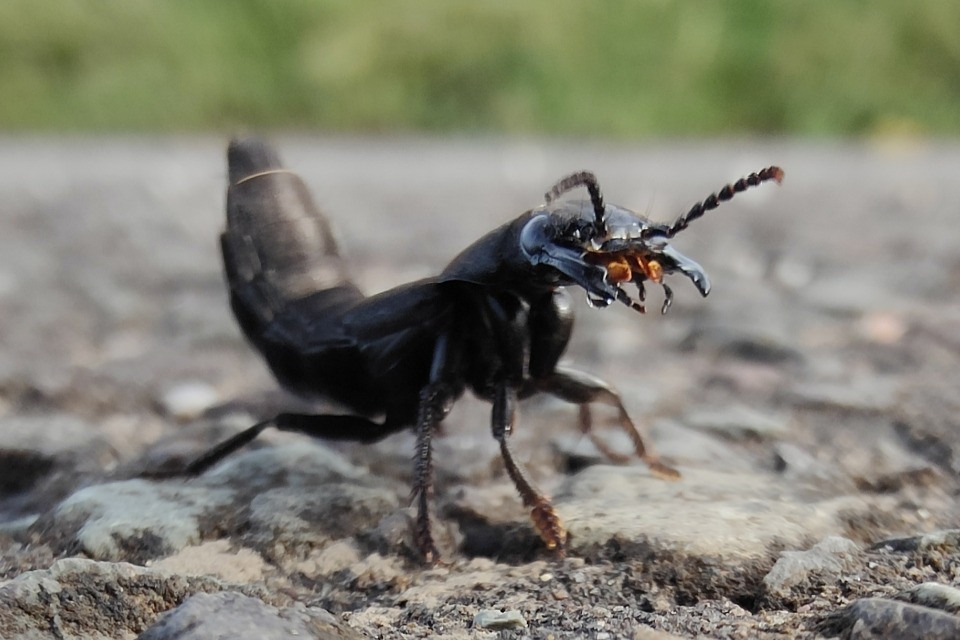Spooky species lurking on Salisbury Plain Training Area
Salisbury Plain Training Area is the biggest military training space in the UK, hosting not only service personnel carrying out vital exercises, but also a huge variety of wildlife.

Wasp spider. Crown copyright
From a wasp spider bringing together two of the most feared creepy crawlies, to a moth with the face of a witch hidden in its wings, this Halloween we’re celebrating some of the spookiest, yet vitally important, species that call the training area home.
While safely enabling military training is the priority, teams from the Defence Infrastructure Organisation (DIO) also work hard to sustainably manage habitats for some of the UK’s most important wildlife. The Ministry of Defence (MOD) operates 169 Sites of Special Scientific Interest (SSSI) across the country, with almost 20,000 hectares on Salisbury Plain alone.
The MOD owns more SSSIs than any other landowner in the UK, including the National Trust, RSPB and The Wildlife Trusts. The main reason for this is because almost all current MOD sites were part of the Defence footprint by the end of World War 2, so they escaped agricultural intensification and were never ploughed up or subject to herbicide and pesticides.

Devil’s Coach Horse beetle. Crown copyright
DIO’s ecology and environmental engagement teams work tirelessly to ensure habitats and species across the Defence Training Estate can thrive alongside military needs. On Salisbury Plain Training Area, this array of wildlife includes some of the spookiest species found in the UK:
Bloody-Nosed Beetle
This rare insect gets its name from its unusual defence mechanism. When threatened, the beetle secretes a blood-red liquid from its mouth. The flightless beetle can be found in grassland and along hedgerows across the training area.
Wasp Spider
Coming across this nightmare-ish combination of a wasp and spider is a very real possibility when out on the Salisbury Plain Training Area. First recorded in England in the 1920s, wasp spiders are mainly found in the south of the country but are spreading northwards as far as Shropshire and Derbyshire, Surrey and Hertfordshire. The creepy-looking spiders have been known to scare even the hardiest of soldiers while out on the training estate – best not to imagine one crawling its way into your sleeping bag.
Viper’s Bugloss
This plant is common across Salisbury Plain Training Area and the wider Defence estate, providing a large amount of nectar for pollinators. It is widely believed to have got the name ‘Viper’ from its spotted stem, resembling a snake’s markings. Sometimes on the training area, ‘rivers’ of the plant are formed where heavy tank tracks rough up the ground and, in a surprising benefit to nature, help to disperse seeds.
Nightjar
The elusive Nightjar can be hard to spot in woodlands due to its camouflaged grey-brown colour that resembles tree bark. The bird has been caught in bird ringing nets on Salisbury Plain. Bird ringing has allowed our teams to record and monitor the birds nesting on the training estate and can be used to influence management plans where appropriate.
Devil’s Coach Horse Beetle
A common beetle, the Devil’s Coach Horse is known for being a ferocious predator, even capable of giving humans a painful bite, if provoked. Not only that, but they are well known for curling their abdomen, similarly to that of a scorpion, when threatened.
Devil’s Bit Scabious
Possibly the most innocent-looking entry on this list, Devil’s Bit Scabious is a pretty plant, with its lilac-blue flower heads attracting wide varieties of butterflies and bees. It gets its peculiar name from the fact the roots look as though they have been bitten off, legend has it, by the devil.
Mother Shipton Moth
Named after a 16th century witch, known for her prophecies, including predicting the Spanish Armada and Great Fire of London, the Mother Shipton Moth can be found amongst the ancient grasslands of Salisbury Plain. The insect features creamy-coloured markings on each forewing, resembling the face of the witch.
Screech Owl
Screech Owls, more commonly referred to as Barn Owls, commonly nest on the training area, with a helping hand from the MOD Raptor and Owl Nest Box Project.
The project was started in 1983 to conserve owls and raptors on the west and centre of the Salisbury Plain Training Area, which lacked suitable nesting sites. Around 400 nesting boxes have been installed across the training area, which have helped to increase the population of various owls on the training estate.
Witches’ Butter
The horrible-looking black or yellow fungi can be found on the bases of certain trees across Salisbury Plain Training Area, as it feeds on dead wood. It is believed to have got its name from the legend that it would appear on a gate or door if a witch had cast a spell on the family living there.
Dog’s Vomit Slime Mould
This species of slime mould, also known as the less scary Scambled Egg Slime, can be found on Salisbury Plain Training Area. It gets its name from its resemblance to dog’s vomit. It is typically found on bark after periods of heavy rain, and its spores can trigger episodes of asthma in some people – making this one to give a wide berth.
Jenny Bennett, Senior Ecologist, Defence Infrastructure Organisation, said:
The MOD is committed to supporting nature recovery at the local and national level, while at the same time enhancing military capability. Our work to protect nationally important species and habitats across Salisbury Plain Training Area is an excellent example of this balance in action.
We aim to be a leader in wildlife and nature conservation and to achieve this, DIO’s dedicated ecologists carry out a broad range of activities, including producing Ecological Impact Assessments, providing advice about protected species, overseeing habitat management on SSSIs and carrying out botanical surveys.
Iain Perkins, Environmental Engagement and Conservation Officer, Defence Infrastructure Organisation, said:
MOD land is home to some of the most unique and naturally diverse landscapes in the UK, of which Salisbury Plain Training area is a prime example. We are committed to maintaining a balance between conservation activities and military training requirements to ensure that species of all shapes and sizes can continue to flourish on our estate.
The DIO environmental engagement team delivers conservation and sustainability awareness initiatives across the Defence estate. It supports the activities of dedicated Conservation Groups at a range of MOD sites and establishments, including monitoring and recording species.
If these creepy creatures and frightening flora haven’t put you off a trip to Salisbury Plain Training Area, please ensure that if you visit, you follow these simple steps to keep yourself and our training personnel safe:
- Check live firing times on GOV.UK.
- Stick to public rights of way and marked permissive paths and tracks.
- Take notice of red flags, red lights and signage which indicate where and when access is prohibited.
- Never touch military debris on the ground. Report it for safe removal.